“Fending Off the Wolves” by ncorva, CC Attribution-Noncommercial-No Derivative Works 3.0 License
With their intelligent hunting prowess, wild bloodthirst, and eerie ability to blend in with common villagers, Lycanthropes (werebeasts) effortlessly add a touch of terror to low-level campaigns. Though most tropes of the Lycanthrope have been explored in cinema and writing, we hope to shed new light on the beloved beast and forge new avenues for Dungeon Masters in implementing this creature in their campaigns.
Lycanthrope Appearances
Canonically, werebeasts assume several forms: werewolf, weretiger, werebear, wereboar, wererats, and the likes. There is also a multitude of homebrew werebeasts, such as werebats, Dungeon Masters can throw into their campaigns.
As a sinister perversion of nature, a Lycanthrope has three transformations: humanoid, hybrid, and animal. Werebeasts are typically medium-sized creatures in the first two forms and a significantly larger and unnatural beast in their animal form. Though a hereditary werebeast can transform at will, with time, the experienced infected may also control their transformation. Nevertheless, in the light of the full moon, the bloodlust becomes too strong, forcing transformation.
According to the Monster Ecology Anthology, a user reference assembled by reddit user Merchent100, the duration of infection affects a humanoids’ appearance:
“The longer an individual lives with the curse, however, the more they begin to take on aspects of their transformation even in their humanoid form. Werebears will grow large, muscular, and hairy in their humanoid forms, Wererats will appear small and nervous with wiry hair, and the Werewolf become sleekly muscular with sharp teeth.” (page 262).
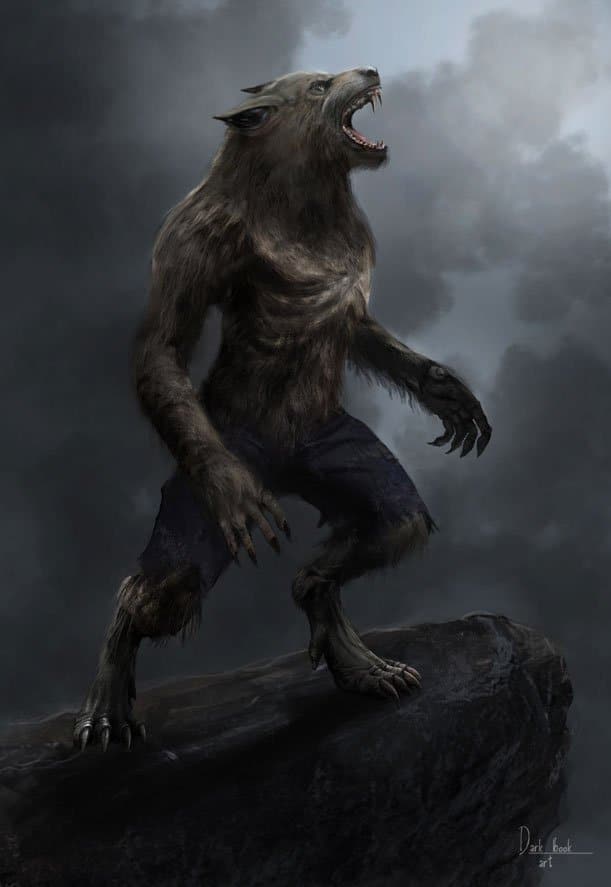
As a hybrid, Lycanthropes stand on two feet, wield weapons, and are capable of speech. They also possess natural weapons (claws, teeth, or tusks) that will curse a target who does not die from the attack.
As animals, they are larger than normal and obviously not natural, yet hinting at something more humanoid.
“Werewolf” by wert23, CC License
From the Monster Manual, pg. 206:
“In that animal form, a werebeast resembles a powerful version of a normal animal. On close inspection, its eyes show a faint spark of unnatural intelligence and might glow red in the dark.”
Behavior
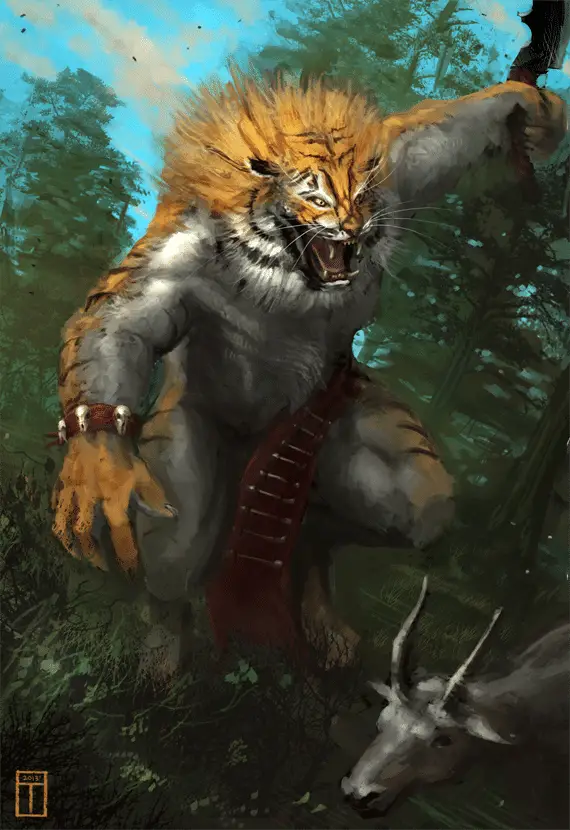
According to the Monster Manual, a werebeast who embraces their curse assumes an evil alignment, giving in to the raging bloodlust within, and embraces their expertise in opportunistically hunting the weak. A werebeast can attempt to resist its curse to keep their good alignment, but most who do live reclusively and are often uncomfortable around normal people.
“Predator and Prey” by TyphonArt, CC License
“It lives its life as it always has, burying deep the bestial urges raging inside it. However, when the full moon rises, the curse becomes too strong to resist, transforming the individual into its beast form-or into a horrible hybrid form that combines animal and humanoid traits. When the moon wanes, the beast within can be controlled once again. Especially if the cursed creature is unaware of its condition, it might not remember the events of its transformation, though those memories often haunt a werebeast as bloody dreams” (Monster Manual, page 206).
Nevertheless, werebeasts tend to congregate with others who are cursed similarly to how their animal namesakes might gather in nature: werewolves and wereboars in wild packs, wererats in cities, werebears and weretigers in the wild in solitude or with their small family. They also tend to assume the hunting tactics of their namesakes when transformed: pack tactics, discrete stalking, wearing down their prey, and so forth.
It is also normal to see werebeasts intelligently leading packs of animals while in their animal form: werewolves become the alpha wolf, wereboars will lead a pack of boars, wererats strategize rat packs. These groups wish to grow their numbers by infecting weaker humanoids so as not to have conflicting alphas.
However, solitary werebeasts may tend to err on the side of caution:
“The more solitary versions, such as Werebear and Weretiger, are far less likely to establish a rapport with other animals, and are much more careful about passing on their curse. Weretigers are especially solitary and reluctant to initiate new Weretigers. Werebears are generally good beings, and pass on their lycanthropy to other protégées who similarly want to act as wardens for the forest, but there are exceptions” (Monster Ecology, pg. 263).
Lycanthrope Traits and Mechanics (5e)
Usually assuming a challenge rating of 3 or 4, werebeasts become easy to defeat when magic weapons are involved. Similarly, werebeasts cursed by a bite can be cured by the Remove Curse spell. Natural-born werebeasts, who inherit their curse from an infected parent, can only have their curse removed with a Wish.
Werebeasts have damage immunities: bludgeoning, piercing, slashing, and damage from non-magical weapons that aren’t silvered. Additionally, in their animal form, most werebeasts can communicate with animals of their type.
From the Monster Manual (pg. 207), we learn the following about werebeasts’ mechanics:
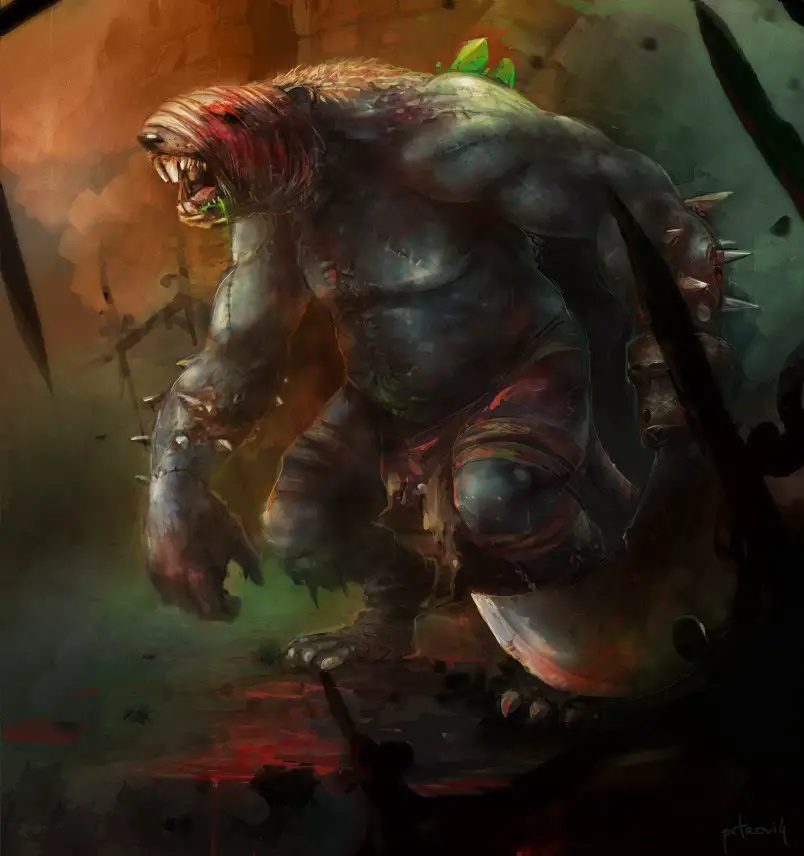
Players who become Lycanthropes retain their statistics unless otherwise specified by the werebeast type. While in hybrid or animal form, characters gain speed, damage immunities, traits, proficiencies in natural weapons, and some actions. But characters in animal form cannot speak.
“Skaven Rat Ogre” by petrovi4, CC License
When hit with a curse-dealing attack, a character must succeed a Constitution Saving Throw, DC 8 + werebeast proficiency bonus + werebeast Constitution modifier in order to avoid being cursed. Players who embrace the curse change their alignment to that of the werebeast.
Unlike most werebeast, Werebears can temper themselves and reject their hysterical bloodlust. Fearful of their capacity to harm the innocent when transformed, Werebears tend to live alone. However, as wardens of the forest, Werebears will take on apprentices, spending time with the newly cursed pupil to teach them how to control themselves by accepting the curse. Werebears tend to be good, but some may be just as evil as other werebeast.
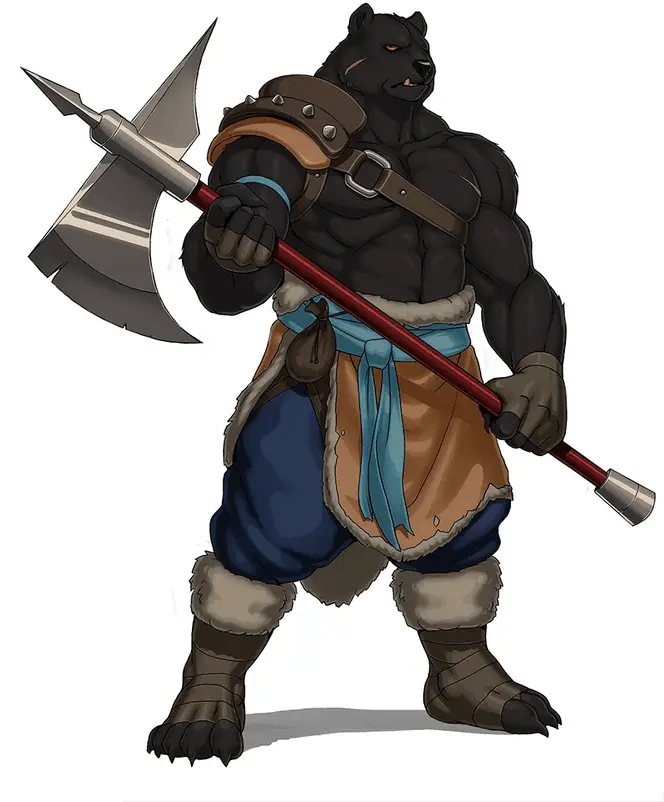
According to the Forgotten Realms Fandom, in bear form, werebears are irritably cantankerous and intently look for evil to slay. They never attack other werebears, and they often allow other werebears access to their fishing grounds, creating a sense of community. Werebears will defend each other against other Lycanthropes. Werebears hardly travel away from home and are difficult to convince to migrate away. They don’t seek adventure and hardly join adventuring parties.
“Wearbear Concept Art” by luigiix, CC License
Humanoid Form: Large and muscular, they are covered in hair, which matches their bear fur.
Hybrid Form: Also known as an ursine, these hybrids grow to an enormous size and use either weapons or claws. They fight ferociously but avoid biting so as not to spread the curse.
Animal Form: See Bear statistics. Alternatively, see all animal statistics from our Beast Statistics Sheet, free to download.
Player Characters who become werebears keep their statistics but gain Strength of 19 (unless already higher), +1 bonus to AC while in boar or hybrid form (natural armor), and attack and damage rolls for their natural weapons are based on Strength.
Wereboars
Ill-tempered and crude, wereboars enjoy spreading the curse haphazardly, relishing the savage wildness that comes from resisting the curse. They throw their weight offensively in close-quarter combat and ferociously charge with their tusks. When mortally wounded, they tend to fight even harder. Wereboars live wildly in small familial groups in forests and sometimes ally themselves with orcs.
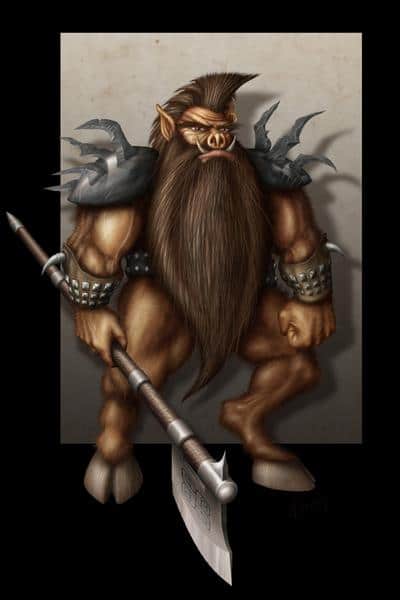
In terms of clothing, according to the Forgotten Realms Fandom, wereboars wear simple clothes that are easy to either tear off when transforming or to mend when torn. Though they rarely make friends, they form unbreakable bonds with their allies, though they may attack a friend all the same. Wereboars born into the curse mature at age 8, when they are able to transform and avoid interacting with natural hogs.
“Dwarf Wereboar” by francisrpnavarro, CC License
Omnivorous, wereboars eat fungi, small game, and vegetables, though terrible farmers and cooks. They are clever at digging for truffles below the earth.
Humanoid Form: Stocky and muscular with short, stiff hair, humanoid wereboars use heavy weapons. Volatile in temper, they provoke conflict and seek brawls.
Hybrid Form: Wereboars gore with their tusks, which spreads infection. Wereboars can charge with a DC of 8 + proficiency bonus + Strength modifier and may use heavy weapons.
Animal Form: Wereboars gore with their tusks, which spreads infection. Wereboars can charge with a DC of 8 + proficiency bonus + Strength modifier and may use heavy weapons.
Player Characters who become wereboars keep their statistics but gain Strength of 17 (unless already higher), +1 bonus to AC while in boar or hybrid form (natural armor), and attack and damage rolls for their natural weapons are based on Strength.
Werewolves
Werewolves tend to flee civilization after infection in fear of harming their loved ones in their bloodlust or their discovery, resulting in punishment for their savage deeds.
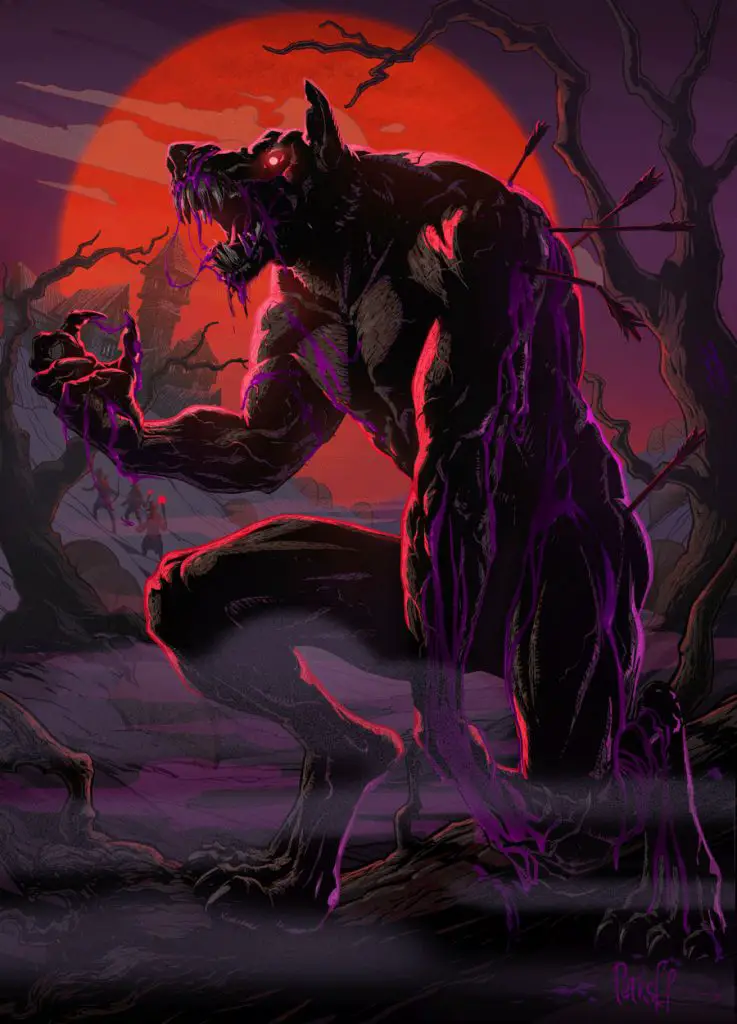
According to the Forgotten Realms Wiki, werewolves “can regenerate most wounds.” The goddess Selûne has a following of non-evil werewolves, as the morals of a pack tend to follow that of the alpha.
“Red Moon Werewolf” by plamen5rov, CC License
Humanoid Form: Werewolves have heightened senses, a raging temper, and an appetite for rare meat.
Hybrid Form: Werewolves appear as a muscled and furred humanoid body with a wolf’s head atop. They wield weapons but prefer claws and teeth.
Animal Form: In the animal form, werewolves form packs with wolves and dire wolves.
Player Characters who become werewolves keep their statistics but gain Strength of 15 (unless already higher), +1 bonus to AC while in wolf or hybrid form (natural armor), and attack and damage rolls for their natural weapons are based on Strength.
Wererats
Cunning and sly, wererats display greed and employ thievery. They are found in catacombs cellars throughout urban cities, usually in clans and utilize ambush tactics.
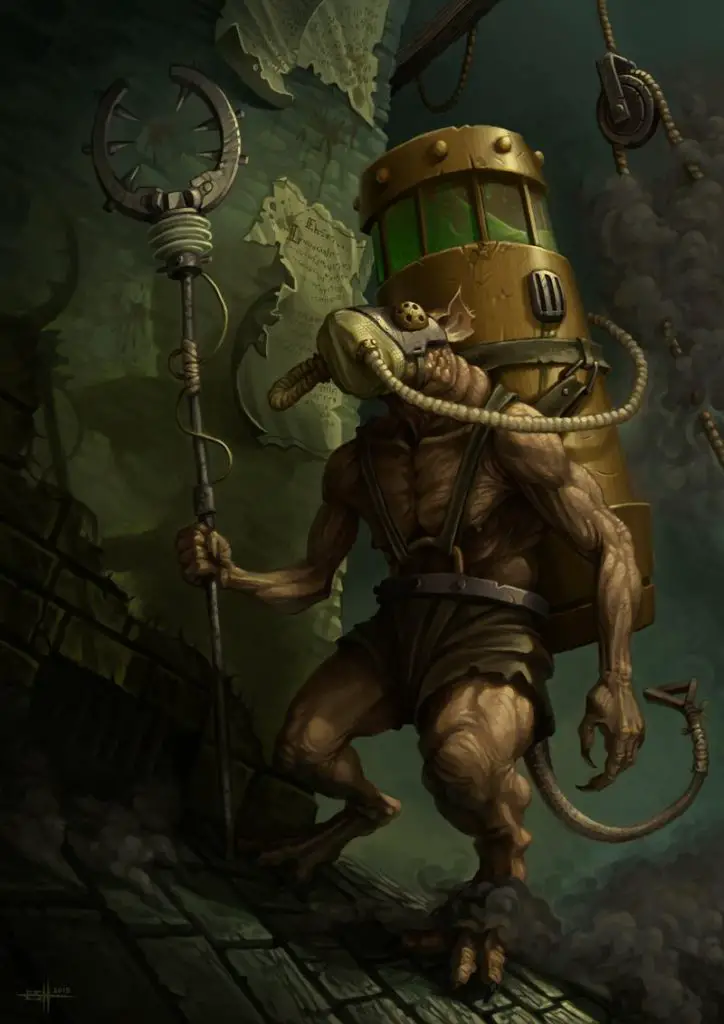
According to the Forgotten Realms Fandom, wererats are cannibals. They also eat uninfected humans and survive on their spoils of thievery. They are also fond of strong alcohol that makes it easy to get drunk. Wererats don’t form intimate relationships beyond pack-mentality. Though weaker than humans, wererats are more intelligent. Because of the Lycanthropy curse, only silver, alchemically silvered, and magical weapons can harm them effectively (non-silver or non-magic damage is reduced).
“Skaven Master” by edgarsh422, CC License
Wererat lairs are often naturally fortified, so packs leave them undefended. These Lycanthropes are also often carriers of Filth Fever.
Humanoid Form: Wererat humanoids are wiry and twitchy with darting eyes and thinning hair. They will use light weapons and stratagem.
Hybrid Form: Can use light weapons or teeth, though bites will infect creatures. Wererats typically only curse those they wish to join the clan. Defectors or undesired wererats are hunted down and killed.
Animal Form: Wererats hardly use their animals forms in combat, reserving this condition for stealth, escape, and infiltration, but they will bite when in a bind (which will spread the curse). Rats and giant rats will often be found with wererat clans.
Player Characters who become wererats keep their statistics but gain Dexterity of 15 (unless already higher), and attack and damage rolls for their natural weapons are based on Strength and Dexterity.
Wereravens
Secretive and cautious, wereravens operate by blending in with society. They oppose evil and are avowed foes to malevolent beings. Wereravens only reveal their true nature to those who have thoroughly and completely earned their trust and respect. They’re extremely picky to whom they spread lycanthropy. Folk tales and rumors describe eerie, raven-like creatures appearing before a disaster, kind of like the Mothman, but these rumors refer to wereravens who arrive to thwart evil.
In any of their shape-changing forms, wereravens have the unique ability to mimic the sounds of other creatures. Wereravens are found in Van Richten’s Guide to Ravenloft.
Humanoid Form: Wereravens tend to indulge in shiny objects. Their cloaks may be embroidered with shiny metals, and they enjoy wearing jewelry. They use light weapons like shortswords and hand crossbows.
Hybrid Form: Their lycanthrope weapon is their beak, though their talons could be used if you don’t mind it being in their statblock.
Animal Form: Wereravens use their raven forms for spying on ill-doers and warning do-gooders. Their raven form is tiny and not useful for combat.
Player Characters who become wereravens keep their statistics but gain Dexterity of 15 (unless already higher), and attack and damage rolls for their beaks are based on either Strength or Dexterity.
Weretigers
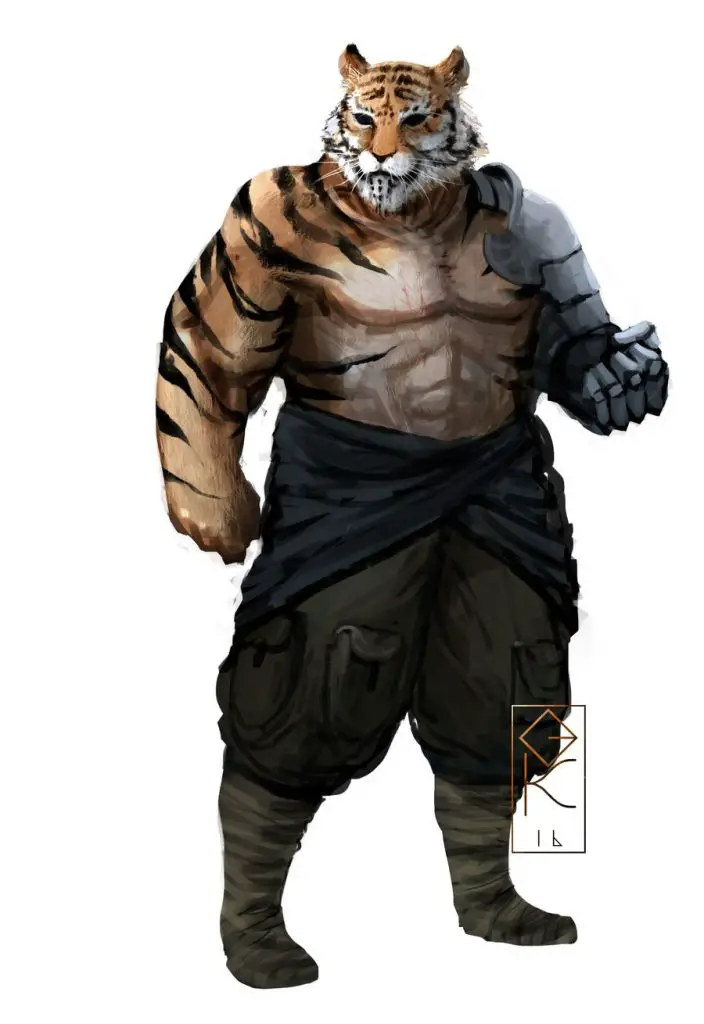
Frightful warriors and effective hunters, weretigers are contemptuous and meticulous. Weretigers live and hunt in isolation, sometimes in small family units, and travel to fringe societies for trade and entertainment. Most evil weretigers worship Malar, the god of the hunt.
“Weretiger” by Gauntes, CC License
Humanoid Form: In this form, weretigers are nimble, muscular, well-groomed, and slightly taller than average. Weretigers prefer to fight in humanoid form so that they don’t spread the curse and create territorial competition. In combat, weretigers are fond of ambush.
Hybrid Form: In this form, weretigers are enormous, but tend to avoid spreading the curse.
Animal Form: In this form, weretigers are enormous, but tend to avoid spreading the curse.
Player Characters who become weretigers keep their statistics but gain a Strength of 17 (unless already higher), and attack and damage rolls for their natural weapons are based on Strength. For the Pounce trait, the DC is 18 + character’s proficiency bonus + Strength modifier.
Other notable werebeasts: Bird maiden, Lythari, Seawolf, Swanmay, Wereape, Werebadger, Werebat, Werebison, Werecat, Werecougar, Werecrocodile, Weredog, Weredolphin, Werefox, Werehyena, Werejaguar, Wereleopard, Werelion, Wereowl, Werepanther, Werepegasus, Wereraven, Wereserpent, Wereshark, Werewyvern
Related Creatures: Aranea, Coyotlwere, Hengeyokai, Jackalwere, Selkie, Shifter, Wolfwere
Werebeast Plot Hooks
A typical werewolf plot includes mystery and fear about an unknown source of murder. We hope to inspire our Dungeon Master readers with additional plot hooks:
- A cult worships werebeasts and aspire to become as such.
- A city is on lockdown. Werebeast gets stuck in city during full moon cycle.
- Mercenaries turn out to be werebeasts.
- Wererats steal people’s stuff in town and hide it in treasure troves in the sewers.
- A jackal is mistaken for a werewolf.
- People in town believe they are werebeasts because of the Dream spell and herbalistic psycoactives.
- Make something besides the full moon stir werebeasts into a frenzy, like weather patterns, or chocolate, or the smell of blood.
- A hunting pack of werebeasts was pushed near town to hunt by an even bigger and scarier threat.
- War between Lycan factions affects a city.
- The party needs to become Lycans to become immune to Polymorph from a powerful wizard foe (Lycans have shapeshifter-immunity).
- The party needs to recruit a werebear who lives in solitude for its tracking skills or forest knowledge.
- After bumping into an unassuming cloaked person on the street, a party member discovers a letter in her pocket, a plea for help to eradicate the werebeasts of the town: the mayor and his closest circle.
- A large region is facing famine, and werebeasts are hunting all of the town’s livestock
- Natives have a ritual in which they celebrate the full moon by turning the eldest into a werebear.
- Priests of a temple accept new pupils and turn them into wererats
- A scientist is trying to discover the secret to lycanthropy, to find a cure, as he himself is cursed. He curses other beings and then experiments on them to find a cure for himself.
- Environmental factor like poisoned water sources, decaying forests, or polluted sewers is pushing werebeasts out of hiding.
- An army of wereboars has captured a town and declared martial law. What they desire: equality.
- Wereboars are the secret weapon in an Orc war.
- Political figures are being brutally assassinated. Werebeast mercenaries are to blame.
- Livestock in the town gather to the top of a hill and refuse to come down. They were directed by werebeasts who sense an oncoming flood or volcano eruption.
- A traveling gypsy (natural lycanthropes) camp comes to town for a festival a week before the full moon. Nearby warring orcs prevent them from moving on when the full moon comes.
- A rat plague threatens the town. The perpetrators: wererats gathering an army.
- A forest burns down, causing a werebear to find refuge. He asks for help in restoring his forest.
- Territory fights between weretigers affect the town.
Questions to Consider in Your Campaign
Before introducing Lycanthropes to your players, consider the following questions, which will help integrate the beasts into your campaign smoothly:
- What signs can you add that there are werebeasts? Do they shed? How do they kill? What physical characteristics do the NPCs have?
- Is the transformation a painful process? Is it a quick transformation?
- How well-known are Lycanthropes to the population?
- Are there existing bounties for werebeasts in towns?
- What happens when a prominent or unknown figure is revealed as a Lycan?
- What will be the result of your player getting cursed? Will they know immediately?
- How are different species of werebeasts treated?
There may also be character options with lycanthrope-like features, like a Barbarian with the Path of the Beast subclass.

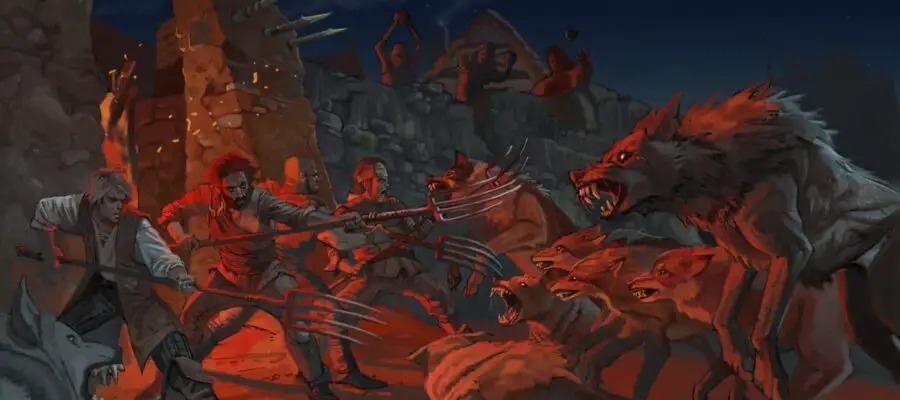
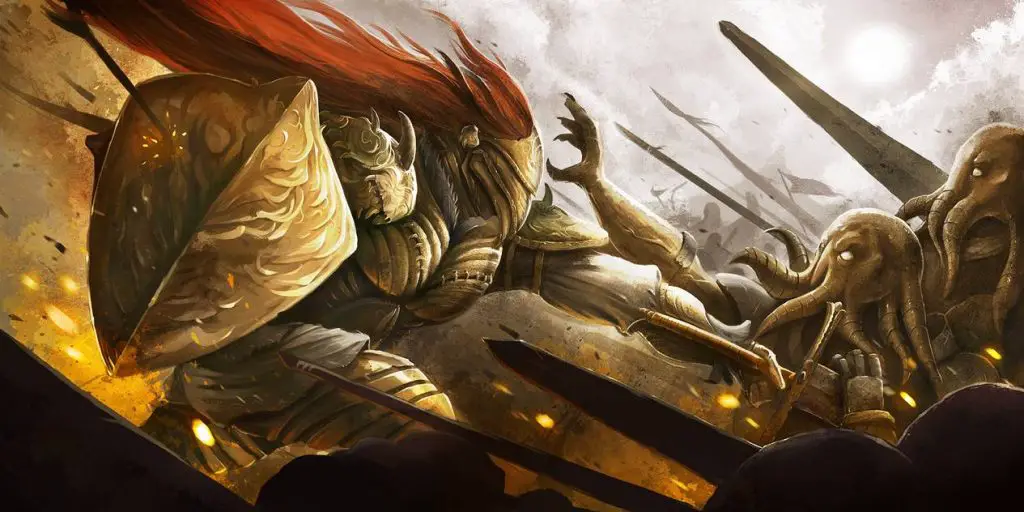

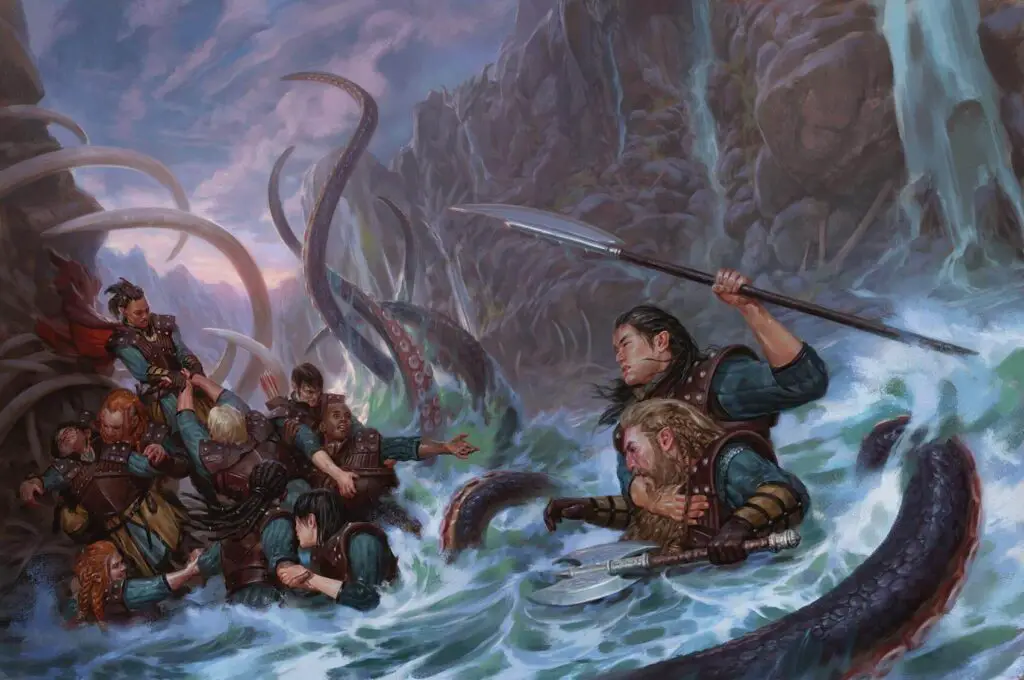
Me, personally, i love lycanthropes. so much, in fact, that i always try to make a werebear character, and assume he’s either natural born, or he can control his curse. it got me wondering: what can you do with lycanthropes particularly, that you can’t do otherwise? for a start, you can begin the game with a Str of 22. how do you do it? first, you make a werebear (not anything else) character. after that, you must do what i say in this exact order: first, use the character building rules in TCoE to take a feat that gives you an ASI in Str, and then use the remaining ASI points, to boost your Str to 22. congratulations, you already have an inhuman strengh, before even adventuring. check with your DM before doing this, because he might not be OK with it
Thanks for the write up Jake! I wrote the article with mostly the DM in mind, and I love that you’re thinking about how to enable players to play with lycanthropy!
I appreciate the creativity, and of course DMs can decide whatever they want, but the order of your steps are flawed.
Choosing a feat before ability score increases is justifiable even if not standard. But if a werebear is a human that becomes cursed, you clearly wouldn’t start with the werebear stats and then get the human ability increase afterwards.
Unless you were born a werebear and caught the curse of “level one human” after getting bit by a homeless guy on the subway.
An amazing article and really helpfull! Trying to build a longer questchain where lychantropy as a whole are centered with more or less all the mixes in there, having all the info given here really helps making that all fit together in a order that actually works!
Thank you Kalle! I love the idea of incorporating lycanthropy into entire civilizations and throwing in the curveball of using unusual werebeasts. I wish your campaign the best! Thanks for reading!